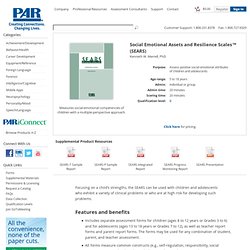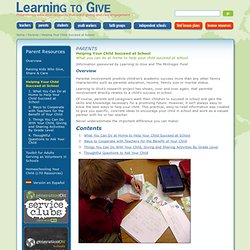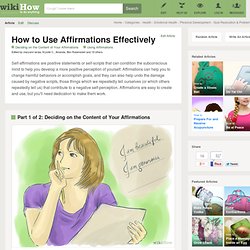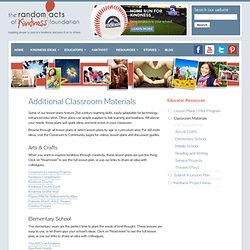

(SEARS) Social Emotional Assets and Resilience Scales. Focusing on a child’s strengths, the SEARS can be used with children and adolescents who exhibit a variety of clinical problems or who are at high risk for developing such problems.

Includes separate assessment forms for children (ages 8 to 12 years or Grades 3 to 6) and for adolescents (ages 13 to 18 years or Grades 7 to 12), as well as teacher report forms and parent report forms. The forms may be used for any combination of student, parent, and teacher assessment. All forms measure common constructs (e.g., self-regulation, responsibility, social competence, empathy), but also include items designed to capture the unique perspective of the rater. Items are phrased as desirable positive characteristics. Brookes Publishing: Strong Start-PreK. Strong Start. Oral Presentation Rubric. Self Acceptance. Summary:This lesson plan integrates Health Standard 1 (self acceptance) with Language Arts Standard 8 (use Technology to Facilitate Writing).

It helps students recognize strengths in themselves and others as well as teaching them to write in verse. Main Curriculum Tie: Health Education - 6th GradeStandard 1 Objective 2Demonstrate acceptance of self and others. *PD Career Connections: Writing Materials: "The Lion Who Couldn't Roar" a picture book by Gary HoggArt paper and supplies (colored pencils, crayons, water colors)Writing paper and pencils Access to computer labPower Point Software. Untitled. Games . Mortifying Monday. It's My Life. Games . Go Go Diego! Personal Strengths, Talents, and Goals.
Summary:Students make a movie/slide show presentation about the unique strengths, talents, and goals of class members.

Main Curriculum Tie: Health Education - 4th GradeStandard 2 Objective 1Discover personal strengths and talents that make one unique. *PD Career Connections: Personnel Director Materials: Video camera or computer with slide show software Reading texts Student Talents and Goals Handout Lined paper for each student. Arthur . Parents & Teachers . About These Activities. Inside The Kindergarten Survival Handbook. Encouraging Social Skills in Young Children. "I feel so sorry for her She'll ask other kids if she can play, and usually they just say, 'No, you're not our friend.' She's trying to be nice.

What more can she do? " "My son seems to have gotten the idea that it's O.K. to terrorize younger children. Yesterday I saw him shove this other little boy, take a shovel he had, and then just ride off on his trike, leaving the other kid almost in tears. " Cooperative Group Game Ideas « Jill Kuzma’s Social Thinking Weblog. Game: Pencil Mini-Golf Skill this address: resisting impulses (to peek) Props: green construction paper, colored pencils,black marker How to Play: Have people work together to draw “mini-golf” pathways on 11×13 pieces of green construction paper with black markers.

Paths should be approximately 3 inches in width, and not too complex. Social Skills Video Social & Emotional Challenges. The Miller Early Childhood Initiative of A WORLD OF DIFFERENCE® Institute. Watering Can Press - Home Page. Friendship Begins with a Smile. Purpose: This lesson introduces children to the importance of facial expressions and while recognizing their impact on other people.

The feelings behind different facial expressions are discussed and the benefits of smiling at each other are emphasized. Students prepare to fill an unmet need for friendship by creating a banner to be given to a group selected by the class as part of a lesson later in this unit. Friendship and Belonging. Quotes Database. Helping Your Child Succeed at School. Helping Your Child Succeed at School What you can do at home to help your child succeed at school.

Information sponsored by Learning to Give and The McGregor Fund Parental involvement predicts children’s academic success more than any other family characteristic such as parental education, income, family size or marital status. Learning to Give’s research project has shown, over and over again, that parental involvement directly relates to a child’s success in school. Angry Feelings (Responsible Personal Conduct) Raising Kids Who Give, Share & Care. Learning to Give - Annotated Bibliography of Children's Literature. Resources Annotated Bibliography of Literature (K-12) At Learning to Give, our resources reach young people wherever they are -- at home and in schools, youth clubs, and after-school programs.

We are also committed to meeting youth wherever they are emotionally and intellectually, and children's literature is a tried-and-true entry point for capturing their hearts and minds. The Learning to Give annotated bibliography represents a growing list of multi-genre children's books with thematic connections to philanthropy, organized in grade clusters, K-2, 3-5, 6-8, and 9-12. So whether you're leading a discussion in class, in a youth group or service-club setting, reading to a child at home, or brainstorming ideas for service-learning projects, you are sure to find just the right book. How to Use Affirmations Effectively. Edit Article Deciding on the Content of Your AffirmationsUsing Affirmations Edited by maryann laraia, Krystle C., Amanda, Ben Rubenstein and 19 others Self-affirmations are positive statements or self-scripts that can condition the subconscious mind to help you develop a more positive perception of yourself.

Affirmations can help you to change harmful behaviors or accomplish goals, and they can also help undo the damage caused by negative scripts, those things which we repeatedly tell ourselves (or which others repeatedly tell us) that contribute to a negative self-perception. Spreading Kindness All Around. Some of our lesson plans feature 21st-century learning skills, easily adaptable for technology-enhanced education.

Other plans use simple supplies to link learning and kindness. Whatever your needs, these plans will spark ideas and kind action in your classroom. Browse through all lesson plans or select lesson plans by age or curriculum area. For still more ideas, visit the Classroom to Community pages for videos, lesson plans and discussion guides. Operation NICE. Kind over matter. David Streight - School Glue.m4a (audio/x-m4a Object) LP Tips PACES. STEP 1: Think about your curriculum. What is one service-learning project that would fit in with the curriculum that your students are studying? ________________________________________________________________ STEP 2: In what particular discipline (class) will the project occur:____________________________________________________________ STEP 3: What is the organization (school, group, etc.) that you will be working with and what are its needs? How will you assess these needs? STEP 4: State the academic goals of the unit that will link service to this organization with learning in the classroom and also name the core ethical values this unit will foster.
STEP 5: What PREPARATION will be necessary for this unit? STEP 6: What SPECIFIC ACTIVITIES will occur in the unit? STEP 7: What Core Curriculum Standards will the unit address? Ea links. Edutopia video clip on SEL. We all have things in common - Language Arts Lesson Plan, Thematic Unit, Activity, Worksheet, or Teaching Idea. Title – We All Have Things in Common By – Shula Sarid Primary Subject – Language Arts Secondary Subjects - Grade Level – 5-8 Group Work The pupils form groups.
They can only have one person they know well. The pupils have to find 10 things they have in common by writing the following: All of us like _____________ All of us have _______________ All of us are ____________ All of us were___________ ________________________________ None of us has _______________ None of us likes _______________ None of us is _______________ None of us were _______________ ______________________________ The pupils choose two things to share with the whole class.
What did you say? - Health / Physical Education Lesson Plan, Thematic Unit, Activity, Worksheet, or Teaching Idea. Links of Compassion. Title – Links of Compassion By – Shelli Pitner Primary Subject – Other Secondary Subjects – Other Grade Level – K-5 Our entire school has become involved in making a paper chain, containing one link for each victim of Tuesday’s Terrorist Attack. The purpose of this is to present a tangible symbol of the number of lives lost, and a means for the students to “connect” with surviving family and friends of the victims by thinking of them as the links are glued one by one.
In addition to the construction of the chain, students have written poems, made drawings, written well wishes, thoughts for peace, etc, and attached them at different intervals. Our chain is already completely around the interior of our school, and, sadly, more links will be added as the numbers rise. The next step will be to create Origami cranes, like those created after the bombing of Hiroshima, and connect them to the chain as well. shellire@gte.net. Lesson Plans - Character Education - Life Skills - Elementary School. Building an intentional culture of excellence and ethics.
This chapter presents a social domain perspective on parenting and moral development. This perspective, as elaborated by Turiel and others (Nucci, in press; Smetana, 1983, 1995a; Tisak, 1995; Turiel, 1979, 1983; Turiel & Davidson, 1986; Turiel, Killen, Studies in Moral Development and Education. National School Climate Center. SECD & SDFS Partners - SCSD@RU. Linois Learning Standards - Social Emotional Learning (SEL) Descriptors - Stage E. Linois Learning Standards - Social Emotional Learning (SEL) Descriptors - Stage A.
Michigan 4-H Youth Development: Character Education. You may be looking for a website belonging to one of the following: College of Agriculture & Natural Resources The founding college of Michigan State University, the College of Agriculture and Natural Resources offers academics in 13 departments, schools and other programs. Visit CANR » MSU Extension Michigan State University Extension is focused on bringing knowledge- based educational programs to the people of the state to improve lives and communities. Visit MSUE » AgBioResearch Formerly known as the Michigan Agricultural Experiment Station, AgBioResearch is one of the largest research organizations at Michigan State University. Visit AgBioResearch » Untitled. SUNY Cortland: Character Education Organizations and Initiatives. Marilyn Watson PhD - Discipline Strategies that Support Character Growth.m4a (audio/x-m4a Object)
WAMC: The Best of Our Knowledge # 1054 (2010-11-29) Untitled. Product Details. Untitled. TeRRiFiCC Teachable Moments: PreK-2 - Resources for Developing Caring Schools - Character Development. Character Development. Educational Resourses for Special Needs. CSEFEL: Center on the Social and Emotional Foundations for Early Learning. CSEFEL: Center on the Social and Emotional Foundations for Early Learning. ES_Lesson_Plan. K-2%20-NPD%20Lesson.